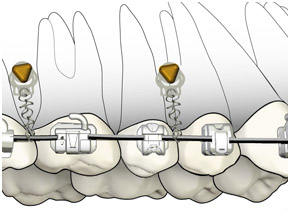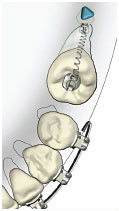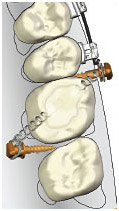What is a TAD?
Temporary Anchorage Device. A TAD is a miniature screw that we position in the mouth. It serves as an anchor for moving specific teeth in the most controlled and predictable way possible. TADS are make of a sterile medical-grade titanium alloy. They eliminate cumbersome appliances (e.g., headgear) and allow us to treat certain cases that were nearly impossible before this technique was refined. TADs also allow us to treat cases better and faster than ever before. TADs are truly revolutionizing orthodontic treatment.
How exactly is the TAD positioned?
After numbing the area where the TAD is to be placed, we use gentle pressure to insert it through the gums and into the bone between your teeth.
Having a TAD placed sounds painful. Should I be worried?
Absolutely not. While it’s normal to assume that the procedure would be painful, it is actually pain free. You may feel some slight pressure during the insertion but no pain. The entire procedure only takes a few seconds.
Do I need to get a shot?
No. There’s an effective way of numbing the the gums that is 100% pain and needle free. First, we apply a fast acting numbing gel where the TAD will be inserted. After the gel desensitizes the area topically, we power spray the gums with a small amount of local anesthetic that completely numbs it. The procedure is entirely pain free.
Will it hurt after the anesthetic wears off?
No. Some patients say they feel a little pressure for a short period of time afterward. Only a few patients have reported needing to use an over the counter medication such as acetaminophen or ibuprophen.
What if it aches the next day?
There is no call for alarm. Minor aching associated with new tooth movement is not only normal, but expected; however if you have concerns, simply call our office and we’ll make an appointment to see you. We’ll probably suggest that you take an over the counter remedy to lessen the ache.
What if the TAD or its attachment causes and irritation inside my cheeks or lips?
For immediate relief, you may be able to cover the attachment that is causing the irritation with a cotton swab or small amount of wax. Call the office and we will provide you with instructions and/or make an appointment to see you.
What if the TAD comes loose?
On occasion, a TAD might become a little loose. In most cases this minor mobility is nothing to be concerned about; however, if you feel that the TAD is excessively loose, or it is causing you discomfort, call the office and we’ll make and appointment to see you and determine if the amount of give is normal.
How do I keep it clean?
We’ll give you a solution with which you will brush the TAD twice a day with a soft toothbrush.
How long will the TAD need to stay in place?
As the name implies, the anchorage device is temporary and is typically removed in a few months when it is no longer needed to assist with tooth movement.
Will it hurt when you remove it?
No. Before we remove it we’ll place numbing gel around the TAD and then back it out gently. The entire process takes only a few seconds.
I’ve never heard of TADs before. Are they new?
Not really. Orthodontists have used TADs since 1983 and oral surgeons and orthopedists have used miniature screws like this for decades longer. Recent refinements in the devices and the procedures for their use have propelled the application of TADs to a heightened level in orthodontics. With TADs, orthodontic treatment options have never been greater. We are proud to be at the forefront of the exciting technology and feel confident that your experience with it will be comfortable and the results exemplary.




